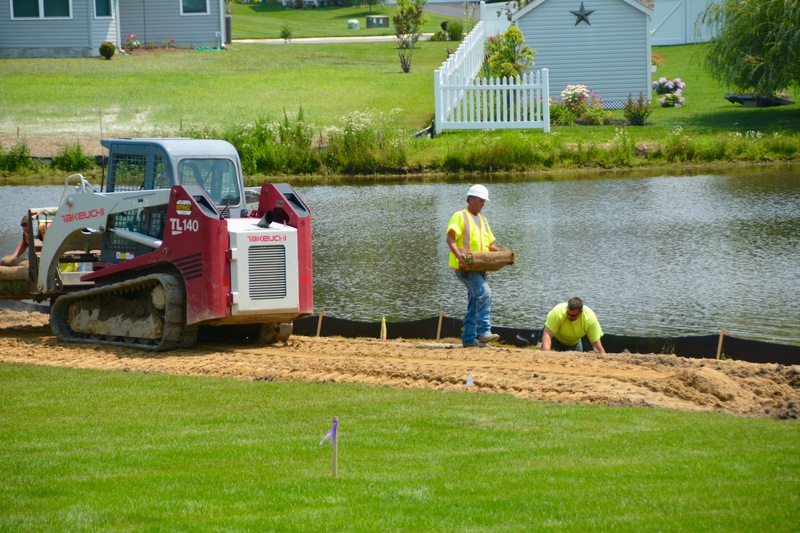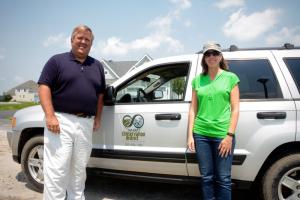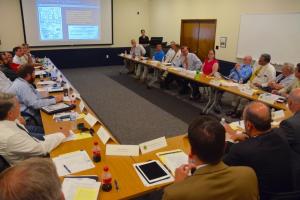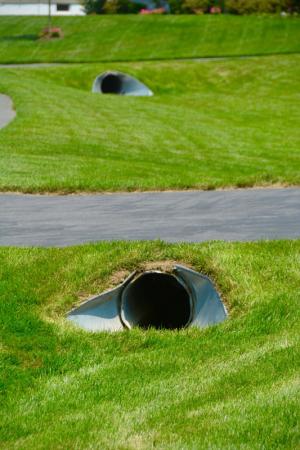Sussex officials take aim at drainage issues
Mention the word drainage, and most Sussex County officials cringe. That's because homeowners are quick to vent frustrations when their properties flood due to real or perceived circumstances beyond their control.
With no regulations to guide grading of new home lots, it's left up to builders and developers. Developers may change over time, and several builders may be working in the same community so continuity becomes an issue.
In some cases, unsuspecting homeowners – most who move or retire to the area – are left with drainage issues that are hard to solve.
“For Sussex County homeowners, it's an issue more often than it needs to be,” says County Administrator Todd Lawson.
Currently, the county does not address drainage or lot-grading in its code. To remedy that, a group of stakeholders has been meeting to develop county drainage standards. The working group is made up of county staff, homeowners, developers and builders.
David Baird, Sussex Conservation District coordinator, said the group's goal is to develop a set of minimum standards to protect quality-of-life issues.
Sussex County Council members attended a June 9 workshop with the committee. Eventually, a draft set of standards will be presented for council consideration. Baird said a presentation to council could be made as early as sometime in August.
A two-pronged approach
Jessica Watson, conservation district sediment and stormwater program manager, said the effort will be twofold including education and design standards.
Under the proposed regulations, lot-grading of single-family homes would be certified by a land surveyor or professional engineer before a certificate of occupancy could be issued. “It would be verified that the lot has positive drainage,” she said, meaning stormwater can get off a lot without impacting surrounding lots.
Under the proposal, single-family lots of one acre or greater would be exempt.
Watson said the proposed grading plan for a community would show first-floor elevations, the minimum grade away from other houses or lots and conveyance channels including more a more defined plan of the slopes of swales.
Committee members agreed that submitting a set of as-built plans to verify a house conforms to grading specifications would cost an additional $300 to $400 for each lot.
There are no regulations in place to keep lots from being built up with additional soil; this ensures water runs off but often onto other lots.
Because neighboring lots are sometime built with higher elevations, Watson said, “Many times, the first ones in a community end up with the water.”
Baird said district, county and state officials get phone calls from frustrated residents with drainage problems after the fact. The district provides technical assistance to builders and developers and meets with homeowners who have problems. In rare cases – such as in Heron Bay near Lewes – the district along with the county, has held up building permits until drainage issues have been rectified.
Watson said some builders in newer communities are already doing proper grading of lots to ensure the community's stormwater management system works.
Committee member Mark Fitzgerald of Schell Brothers said it pays to do it right the first time.
Unfortunately, he said, many approved stormwater systems are designed to fail. He said Schell recently paid $500,000 to fix one community's system after the company took it over. “It cost three times as much to fix something,” he said.
The slope and depth of roadside swales is a matter of concern for local builders. Many times, swales do not have enough slope to provide proper water flow.
Builder Scott Dailey of Capstone Homes said area builders need minimal specifications designed for the real world with at least a change in the minimum slope required by the county for roadside swales. “That spec needs to change,” he said.
Bob Horsey of David G. Horsey & Sons said roadside swales are the culprit. “Swales are the beginning of everything,” he said. “The slope needs to be increased, and we also need to deal with the side and back swales.”
All about Sussex County swales
If builders do not use curbs and gutters with underground pipes to channel water runoff into stormwater ponds or other retention areas, they either swales or bioswales.
Because of environmental benefits, swales are promoted by the district as part of a stormwater management system.
The committee agreed that more education is needed so homeowners understand how swales function and how they should be maintained. Watson said the district has published a series of information guides on swales and their management to be distributed to residents throughout Sussex County. “Many people have not seen swales and do not know how they are supposed to function,” Watson said.
Swales are open grass channels that convey water runoff to a point of discharge including catch basins, culvert pipes and stormwater facilities.
Roadside swales run parallel to the road, located in the right-of-way and are intended to handle road water runoff. Many residential subdivisions in Sussex County have privately maintained roads with these types of swales that are reviewed and inspected by Sussex County public works. Once the road and swales have been approved by Sussex County, the roads and swales become the responsibility of the developer until the roads and swales are turned over to the community's homeowners association.
Roadside swales are not owned by an individual property owners, but backyard and sideyard swales are owned by property owners.
According to the conservation district, vegetated swales are the preferred method of conveying stormwater runoff because they filter pollutants; slow down runoff; encourage infiltration; recharge groundwater; help alleviate downstream flooding; and are low maintenance and cost effective.
Watson said the conventional system of storm drains with curbs and gutters is an effective method to move stormwater, but it does not provide the environmental benefit of filtering and slowing down the water.
In Sussex County, Watson said, roadside swales are designed to convey a 10-year-storm event, which is 5.3 inches of rain in 24 hours. She said it is expected that water in the swales will flow during heavy rain storms and recede in a reasonable amount of time. However, she said, it's not unusual for swales to remain soggy or wet following storms.
Bioswales are typically larger areas of green technology that are engineered to meet certain stormwater criteria. They are typically located in a community's open space or in drainage/stormwater easement areas.
County engineer Mike Izzo said the proposed regulations would apply to future developments but would not address issues faced in existing communities.
Watson agreed. She said drainage complaints will continue to surface in existing developments even if new lot-grading regulations are enacted.
Enforcement of the proposed regulations has not yet been determined, but will be worked out by the committee. The county and conservation district could share enforcement responsibility.
















































